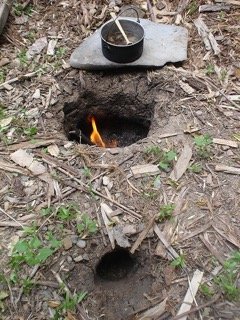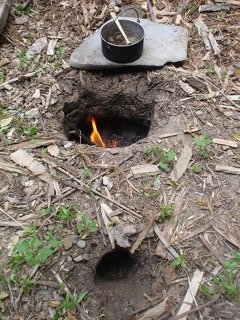 I’m not quite sure who came up with the typical rock-ring fire pit, but obviously they weren’t worried about efficiency or eco-friendliness. Everywhere you look, the remains of many a campsite disrupts the beauty of our natural places. In most of our natural parks, rangers stay pretty busy erasing these unsightly scars left by campers.
I’m not quite sure who came up with the typical rock-ring fire pit, but obviously they weren’t worried about efficiency or eco-friendliness. Everywhere you look, the remains of many a campsite disrupts the beauty of our natural places. In most of our natural parks, rangers stay pretty busy erasing these unsightly scars left by campers.
Our ancestors did things differently. If you study indigenous tribes, you’ll notice a few similarities when it comes to fire. The most noticeable is the absence of rocks around them, and their sunken design.
I teach wilderness skills at an ancient 38 acre Maidu village. My mentor is a Maidu elder and we honor the traditional fire pit in our teachings. The Maidu used a simple pit, sunken about 10 inches and lined with clay. There is no rock ring around it and it works great. The Dakota tribes had an even better idea and I haven’t found a more efficient or easy to dismantle fire pit around. Here’s how it works.
A hole is dug in the ground that’s about 12 inches deep and 12 inches wide. You can widen out the bottom a bit to handle bigger wood, but it is important to keep the top around a foot in diameter for efficiency and cooking ease. Here’s where it gets interesting . . . Dig a smaller hole (about six inches around) as an air-intake that connects to the main hole. Start a couple of feet away and dig at an angle until the two holes connect (try to make the air vent upwind to increase oxygen to the fire). Here’s five reasons why this is a superior way to build a fire:
1. First and foremost in my book is how easy it is to erase the eyesore of your campsite after you leave. It is super easy to fill in and make it look like you were never there. Leave the cap (grassy part you took off the top) somewhere so you can put it back on top of the hole. Another advantage is that you decrease the chances of unquenched coals flaring up and starting a fire.
2. This fire burns amazingly hot because of the air vent. Cooking and boiling water is a snap.
3. This type of fire is great when it’s windy. It will burn hot and keep burning in the wind and again, you won’t have sparks flying into the trees like a normal fire on windy days.
4. Because of the design, you will use much less wood. Be sure to use a good hardwood for fuel and it will burn a long time.
5. You won’t have rocks to stumble over (or explode if they have moisture in them) and you can easily add a tripod, a flat cooking rock partially over the opening or green sticks to lay your coffee pot on.
 One other thing I like about the Dakota fire hole is that it is fairly stealth. If you don’t want to let all the other people in the woods know your location, this is a good way to go. The design makes it smoke less (because of how hot it burns), and the flames are below ground (out of sight). And, you get to see a lot more of your surroundings at night without being blinded by the light from the flames (important if Sasquatch is sneaking into your camp). When you’re done, just fill it in and honor the rule of the wild — “Leave no trace.”
One other thing I like about the Dakota fire hole is that it is fairly stealth. If you don’t want to let all the other people in the woods know your location, this is a good way to go. The design makes it smoke less (because of how hot it burns), and the flames are below ground (out of sight). And, you get to see a lot more of your surroundings at night without being blinded by the light from the flames (important if Sasquatch is sneaking into your camp). When you’re done, just fill it in and honor the rule of the wild — “Leave no trace.”
Photo credit: Survivalboards.com








